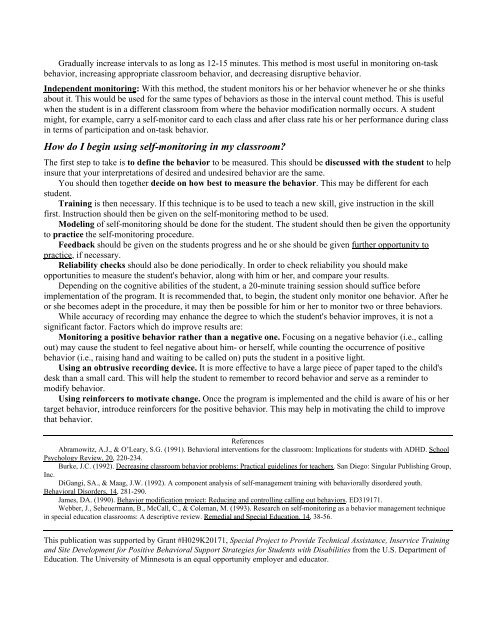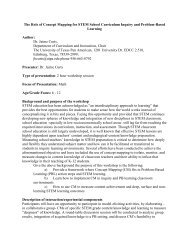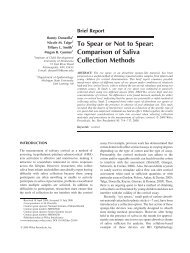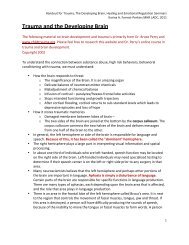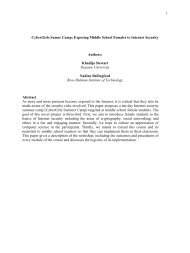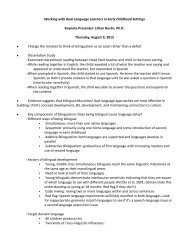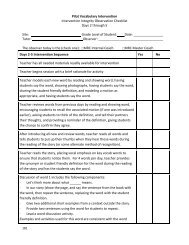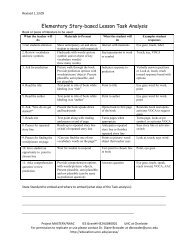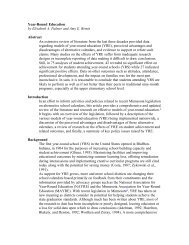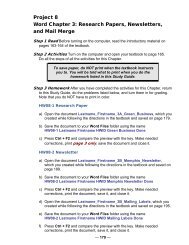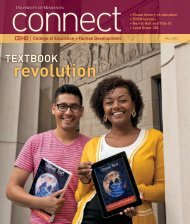Introduction to Positive Ways of Intervening with Challenging Behavior
Introduction to Positive Ways of Intervening with Challenging Behavior
Introduction to Positive Ways of Intervening with Challenging Behavior
Create successful ePaper yourself
Turn your PDF publications into a flip-book with our unique Google optimized e-Paper software.
Gradually increase intervals <strong>to</strong> as long as 12-15 minutes. This method is most useful in moni<strong>to</strong>ring on-task<br />
behavior, increasing appropriate classroom behavior, and decreasing disruptive behavior.<br />
Independent moni<strong>to</strong>ring: With this method, the student moni<strong>to</strong>rs his or her behavior whenever he or she thinks<br />
about it. This would be used for the same types <strong>of</strong> behaviors as those in the interval count method. This is useful<br />
when the student is in a different classroom from where the behavior modification normally occurs. A student<br />
might, for example, carry a self-moni<strong>to</strong>r card <strong>to</strong> each class and after class rate his or her performance during class<br />
in terms <strong>of</strong> participation and on-task behavior.<br />
How do I begin using self-moni<strong>to</strong>ring in my classroom?<br />
The first step <strong>to</strong> take is <strong>to</strong> define the behavior <strong>to</strong> be measured. This should be discussed <strong>with</strong> the student <strong>to</strong> help<br />
insure that your interpretations <strong>of</strong> desired and undesired behavior are the same.<br />
You should then <strong>to</strong>gether decide on how best <strong>to</strong> measure the behavior. This may be different for each<br />
student.<br />
Training is then necessary. If this technique is <strong>to</strong> be used <strong>to</strong> teach a new skill, give instruction in the skill<br />
first. Instruction should then be given on the self-moni<strong>to</strong>ring method <strong>to</strong> be used.<br />
Modeling <strong>of</strong> self-moni<strong>to</strong>ring should be done for the student. The student should then be given the opportunity<br />
<strong>to</strong> practice the self-moni<strong>to</strong>ring procedure.<br />
Feedback should be given on the students progress and he or she should be given further opportunity <strong>to</strong><br />
practice, if necessary.<br />
Reliability checks should also be done periodically. In order <strong>to</strong> check reliability you should make<br />
opportunities <strong>to</strong> measure the student's behavior, along <strong>with</strong> him or her, and compare your results.<br />
Depending on the cognitive abilities <strong>of</strong> the student, a 20-minute training session should suffice before<br />
implementation <strong>of</strong> the program. It is recommended that, <strong>to</strong> begin, the student only moni<strong>to</strong>r one behavior. After he<br />
or she becomes adept in the procedure, it may then be possible for him or her <strong>to</strong> moni<strong>to</strong>r two or three behaviors.<br />
While accuracy <strong>of</strong> recording may enhance the degree <strong>to</strong> which the student's behavior improves, it is not a<br />
significant fac<strong>to</strong>r. Fac<strong>to</strong>rs which do improve results are:<br />
Moni<strong>to</strong>ring a positive behavior rather than a negative one. Focusing on a negative behavior (i.e., calling<br />
out) may cause the student <strong>to</strong> feel negative about him- or herself, while counting the occurrence <strong>of</strong> positive<br />
behavior (i.e., raising hand and waiting <strong>to</strong> be called on) puts the student in a positive light.<br />
Using an obtrusive recording device. It is more effective <strong>to</strong> have a large piece <strong>of</strong> paper taped <strong>to</strong> the child's<br />
desk than a small card. This will help the student <strong>to</strong> remember <strong>to</strong> record behavior and serve as a reminder <strong>to</strong><br />
modify behavior.<br />
Using reinforcers <strong>to</strong> motivate change. Once the program is implemented and the child is aware <strong>of</strong> his or her<br />
target behavior, introduce reinforcers for the positive behavior. This may help in motivating the child <strong>to</strong> improve<br />
that behavior.<br />
References<br />
Abramowitz, A.J., & O’Leary, S.G. (1991). <strong>Behavior</strong>al interventions for the classroom: Implications for students <strong>with</strong> ADHD. School<br />
Psychology Review, 20, 220-234.<br />
Burke, J.C. (1992). Decreasing classroom behavior problems: Practical guidelines for teachers. San Diego: Singular Publishing Group,<br />
Inc.<br />
DiGangi, SA., & Maag, J.W. (1992). A component analysis <strong>of</strong> self-management training <strong>with</strong> behaviorally disordered youth.<br />
<strong>Behavior</strong>al Disorders, 14, 281-290.<br />
James, DA. (1990). <strong>Behavior</strong> modification proiect: Reducing and controlling calling out behaviors. ED319171.<br />
Webber, J., Seheuermann, B., McCall, C., & Coleman, M. (1993). Research on self-moni<strong>to</strong>ring as a behavior management technique<br />
in special education classrooms: A descriptive review. Remedial and Special Education. 14, 38-56.<br />
This publication was supported by Grant #H029K20171, Special Project <strong>to</strong> Provide Technical Assistance, Inservice Training<br />
and Site Development for <strong>Positive</strong> <strong>Behavior</strong>al Support Strategies for Students <strong>with</strong> Disabilities from the U.S. Department <strong>of</strong><br />
Education. The University <strong>of</strong> Minnesota is an equal opportunity employer and educa<strong>to</strong>r.


